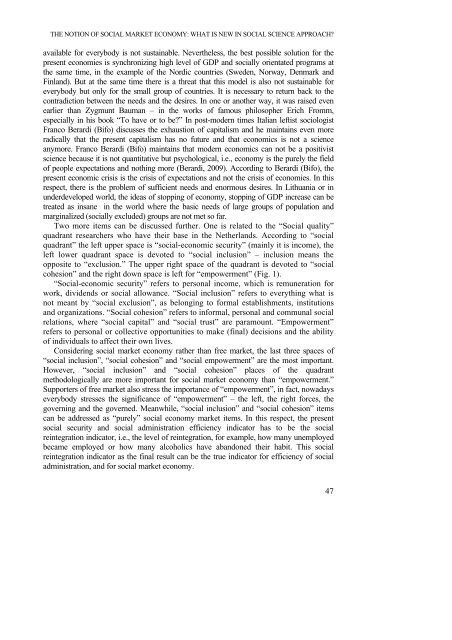2011,4 (57) - KlaipÄdos universitetas
2011,4 (57) - KlaipÄdos universitetas
2011,4 (57) - KlaipÄdos universitetas
You also want an ePaper? Increase the reach of your titles
YUMPU automatically turns print PDFs into web optimized ePapers that Google loves.
THE NOTION OF SOCIAL MARKET ECONOMY: WHAT IS NEW IN SOCIAL SCIENCE APPROACH?<br />
available for everybody is not sustainable. Nevertheless, the best possible solution for the<br />
present economies is synchronizing high level of GDP and socially orientated programs at<br />
the same time, in the example of the Nordic countries (Sweden, Norway, Denmark and<br />
Finland). But at the same time there is a threat that this model is also not sustainable for<br />
everybody but only for the small group of countries. It is necessary to return back to the<br />
contradiction between the needs and the desires. In one or another way, it was raised even<br />
earlier than Zygmunt Bauman – in the works of famous philosopher Erich Fromm,<br />
especially in his book “To have or to be?” In post-modern times Italian leftist sociologist<br />
Franco Berardi (Bifo) discusses the exhaustion of capitalism and he maintains even more<br />
radically that the present capitalism has no future and that economics is not a science<br />
anymore. Franco Berardi (Bifo) maintains that modern economics can not be a positivist<br />
science because it is not quantitative but psychological, i.e., economy is the purely the field<br />
of people expectations and nothing more (Berardi, 2009). According to Berardi (Bifo), the<br />
present economic crisis is the crisis of expectations and not the crisis of economies. In this<br />
respect, there is the problem of sufficient needs and enormous desires. In Lithuania or in<br />
underdeveloped world, the ideas of stopping of economy, stopping of GDP increase can be<br />
treated as insane in the world where the basic needs of large groups of population and<br />
marginalized (socially excluded) groups are not met so far.<br />
Two more items can be discussed further. One is related to the “Social quality”<br />
quadrant researchers who have their base in the Netherlands. According to “social<br />
quadrant” the left upper space is “social-economic security” (mainly it is income), the<br />
left lower quadrant space is devoted to “social inclusion” – inclusion means the<br />
opposite to “exclusion.” The upper right space of the quadrant is devoted to “social<br />
cohesion” and the right down space is left for “empowerment” (Fig. 1).<br />
“Social-economic security” refers to personal income, which is remuneration for<br />
work, dividends or social allowance. “Social inclusion” refers to everything what is<br />
not meant by “social exclusion”, as belonging to formal establishments, institutions<br />
and organizations. “Social cohesion” refers to informal, personal and communal social<br />
relations, where “social capital” and “social trust” are paramount. “Empowerment”<br />
refers to personal or collective opportunities to make (final) decisions and the ability<br />
of individuals to affect their own lives.<br />
Considering social market economy rather than free market, the last three spaces of<br />
“social inclusion”, “social cohesion” and “social empowerment” are the most important.<br />
However, “social inclusion” and “social cohesion” places of the quadrant<br />
methodologically are more important for social market economy than “empowerment.”<br />
Supporters of free market also stress the importance of “empowerment”, in fact, nowadays<br />
everybody stresses the significance of “empowerment” – the left, the right forces, the<br />
governing and the governed. Meanwhile, “social inclusion” and “social cohesion” items<br />
can be addressed as “purely” social economy market items. In this respect, the present<br />
social security and social administration efficiency indicator has to be the social<br />
reintegration indicator, i.e., the level of reintegration, for example, how many unemployed<br />
became employed or how many alcoholics have abandoned their habit. This social<br />
reintegration indicator as the final result can be the true indicator for efficiency of social<br />
administration, and for social market economy.<br />
47
















